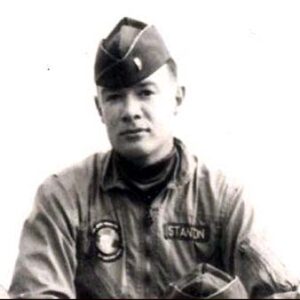Ben Stanton flew the F-100 from 1957-1960 with the 9th TFS, (388th FBW) 49th TFW out of Etain AB, France and Spangdahlem AB, Germany.
Ben Stanton – Caterpillar Club Story
 My first operational assignment in the fall of 1957 after F100A transition at Nellis was to Etain AB, France, in the old 388th FBW, 563rd FBS flying F100Ds. Not long after my arrival, we were redesignated as the 49th TFW. At that time there were 3 tactical fighter squadrons, the 7th TFS, 8th TFS, and 9th TFS. The weather in Northern France was normally crappy and only category “A” pilots (?) got to fly the meager hours we could squeeze out of the new F100s. As a new 2nd Lt., I was sent TDY to Wheelus AB, Tripoli, Libya, where we kept a rotational squadron for weapons qualification and some good old VFR flying time.
My first operational assignment in the fall of 1957 after F100A transition at Nellis was to Etain AB, France, in the old 388th FBW, 563rd FBS flying F100Ds. Not long after my arrival, we were redesignated as the 49th TFW. At that time there were 3 tactical fighter squadrons, the 7th TFS, 8th TFS, and 9th TFS. The weather in Northern France was normally crappy and only category “A” pilots (?) got to fly the meager hours we could squeeze out of the new F100s. As a new 2nd Lt., I was sent TDY to Wheelus AB, Tripoli, Libya, where we kept a rotational squadron for weapons qualification and some good old VFR flying time.
On March 11, 1958, I was on a solo mission just to build up time so the wing would not lose any allotted flying hours. After a couple of hours droning up and down the coast of the Med, I developed an engine vibration. I notified Wheelus Tower and turned toward the base, about 50 miles away. The problem progressed rapidly and the vibration got so extreme I could not read the instruments. I could, however, easily discern the Forward Fire Warning Light. The dash-one at that time said that under these conditions, prompt ejection ensures the greatest chance of survival. I decided I agreed and informed the Tower of my intent to eject. I cinched down my leg straps, assumed the straight up, head back, feet in the stirrups position, and raised the armrests to jettison the canopy. At this time, I estimated I was at about 350 kts. and 10,000 ft.
The canopy left as advertised and all kinds of crap, maps, checklists, and just plain dirt hit me in the face in my 350 kt. convertible. I groped for the seat trigger and couldn’t find it. I guess it was purposely set very wide to prevent inadvertent ejection if you just wanted to blow the canopy. I looked down and thought, oh, there it is, and squeezed it with my head turned down and to the right. Bad idea, twenty years later, I had to have C1 and C2 vertebrae fused because of continual neck problems. Otherwise, separation from the aircraft was OK. This was before the rocket seat, just one quick 30-G blast. We had a 1-second lap belt delay, which they said we couldn’t beat. But being the hot jock that I was, I looked down before it opened. After staring at it for a couple of seconds, I realized that son-of-bitch wasn’t going to open! So I manually opened it and pulled my D-ring. Oops, should have kicked away from the seat first. Luckily the air stream saved me on that one I guess, as the chute opened above me okay.
In this era, our survival gear consisted of a yellow Mae West worn under the parachute harness and a one-man dinghy that we sat on and attached to the rings on the bottom of the harness. We had a lanyard from the dinghy that we attached to the Mae West and if you tried to climb out of the cockpit after landing it would tug on the Mae West to remind you to unhook it. A major problem with the dinghy was that the hooks for the harness were too short and pulled your shoulders down throughout flight. As a result, most of us only hooked up one side which eliminated the discomfort. That was the way I had mine so I expected it was gone after the chute opened.
The immediate problem, however, was something kept hitting me upside the head every few seconds. We had a small strap on the end of our O2 hose that was snapped around our chest strap. My helmet had come off during ejection, but the O2 mask remained attached. The helmet was swinging around in a six-foot circle at the end of the O2 hose and hitting me in the head each time it went by. I unhooked it and tossed it away. Now, prior to leaving the bird, I was about over the beach heading slightly out to sea.
On the left, I could see desert and on the right, water. Once I got settled in the chute, I could see I had slightly miscalculated and was going to land about a half-mile offshore. I had seen a large splash which I assumed was the F100. There was a T-33 circling around the area, so I got out a survival mirror I carried and tried to flash it at him as I descended. Never did find out if that worked or not. I tried pulling first on one riser then the other in an effort to steer the chute toward land. Couldn’t see it having any effect so had to prepare for a water landing. I followed the current procedures which included, inflating one-half of the Mae West after unhooking the chest strap so it would not crush your chest.
The sea state was light and I landed in the water drifting backward at about 10 kts. Since my chest strap was unhooked, the chute harness was immediately pulled off my shoulders and the quick disconnect was way out of reach behind me. I had done a hell of a job of cinching the leg straps and could not get them unhooked. I had a small wake coming over my shoulders, and in retrospect, since there was an onshore breeze, it would have been cool to just para-sail up to the beach. But no – we had been trained to collapse that chute immediately. So I tugged and struggled and got the chute collapsed. The next thing I noticed was a familiar tug on the Mae West and low and behold I pulled in the line to find my dinghy still attached. I inflated it quickly and crawled aboard. Next, I finally got the leg straps unhooked, but now I was hopelessly entangled in shroud lines. The chute was now acting as a giant sea anchor and each time I let go of the sides of the raft it would try to pull me out. I managed to get out a small knife I carried in my shoulder pencil holder and began sawing on shroud lines. Just as I got the last one cut, I heard a loud splash and looked up to see the wonderful sight of an SA 16 landing nearby. All problems were now over.
Not quite. The SA 16 began backing up to me in reverse and it was evident the dinghy was going to be sucked under the prop, so I had to bail out of it. The crewman at the side door hauled me in, and after they recovered the dinghy ( I think it was some kind of a prize for them) we headed back to Wheelus.
They never recovered the aircraft, and the board surmised it was a number six-bearing failure with a subsequent fire. The Commander of the 7th TFS who owned the A/C was more than a little pissed that a 2nd Lt. from the 9th had jumped out of his bird. Unfortunately, they were preparing a press release on that F100 as being the first to ever attain 1,000 hours on the same airframe and engine. Didn’t happen!
A subsequent check of all Wing aircraft found that a number of them had the striker, which activated the automatic lap belt, installed backward, so it would never hit the armor plate behind the seat as designed during ejection, negating any auto lap belt action. Yes, the learning curve in those days was steep! ~ Ben Stanton



